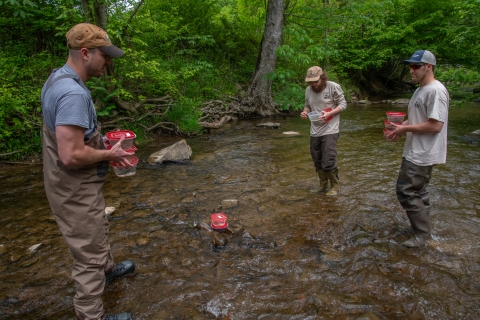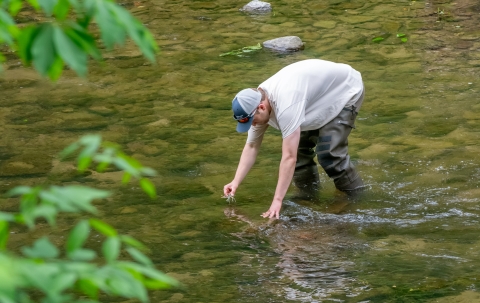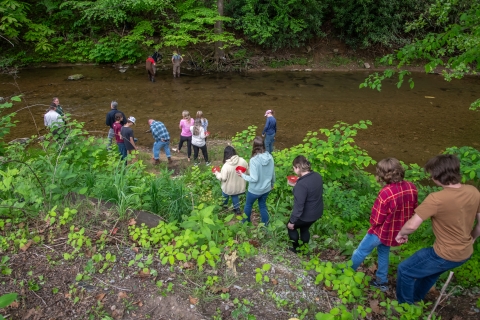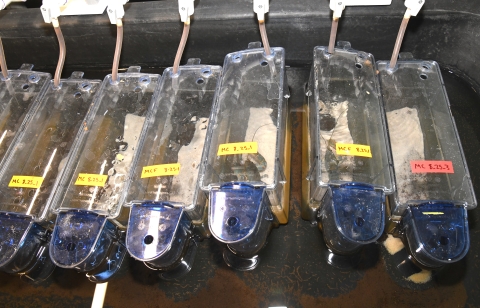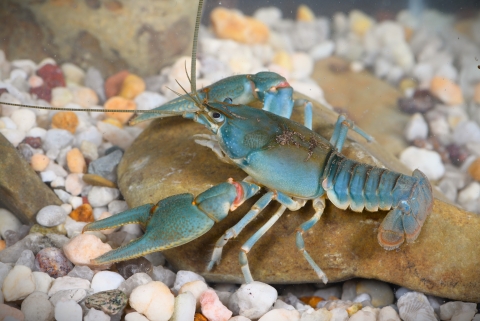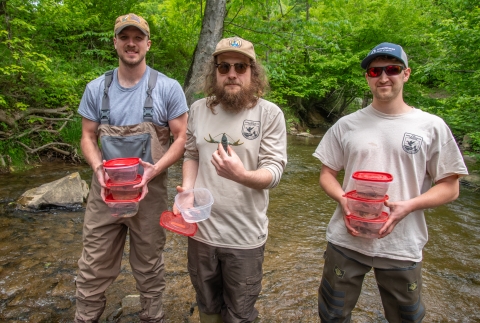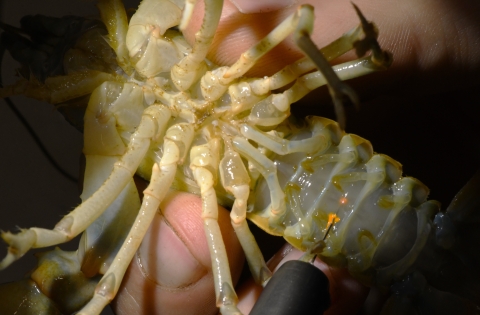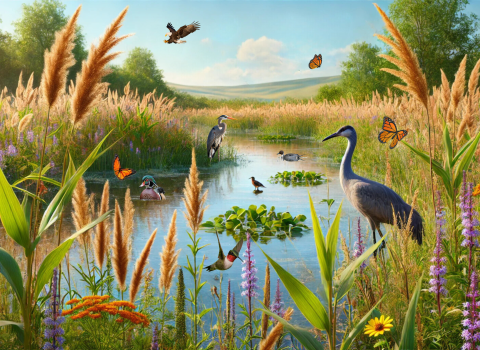A crew in waders strode into the rippling McClure River — each individual carrying a clear, plastic container with a scurrying, blue-green creature inside. Walking carefully through knee-deep water, they scanned the river bottom, eyeing a few large boulders.
Without much pomp and circumstance, the biologists lifted the animals from the vessels — gripping each crustacean behind its claws — and placed them in the river next to the rocks.
“Off you go.”
This was graduation day for the Big Sandy crayfish reared at White Sulphur Springs National Fish Hatchery in West Virginia. Having learned how to raise the species at the lab, the biologists released the first successful cohort — 77 crayfish — at multiple sites throughout Virginia's McClure River.
The bright-blue crustaceans scampering across the river bottom to shelter represented a huge leap towards recovery for the federally threatened species. This is the first time hatchery-reared Big Sandy crayfish have been released back into their native Virginia waters.
No place to hide
Found only in the Big Sandy River basin in Virginia, Kentucky and West Virginia, Big Sandy crayfish protect themselves from predators by sheltering in small depressions under large rocks. They rely on clean, healthy streams and waterways for survival — accumulated sediment between rocks results in fewer hiding places.
“Not only does sediment reduce the amount of available habitat for Big Sandy crayfish, but it also reduces the amount of available habitat for prey for the species, like macroinvertebrates,” said Riley Aulick, wildlife biologist at the West Virginia Ecological Services Field Office and the national recovery lead for Big Sandy crayfish.
Unfortunately, mining, timber harvest and other activities that can increase sedimentation have shrunk their habitat and left the crayfish vulnerable to becoming endangered. In 2016, Big Sandy crayfish was listed as threatened and is now protected under the Endangered Species Act.
Perseverance
As part of the species’ recovery outline, in 2018, biologists at White Sulphur Springs National Fish Hatchery began efforts to rear the crayfish for stocking, in partnership with Virginia Department of Wildlife Resources and West Liberty University Crayfish Conservation Laboratory. The hatchery specializes in rare and endangered species, including the candy darter and salamander mussel.
But propagating Big Sandy crayfish was easier said than done.
“No one really knew what to do,” said Drew Phipps, fish and wildlife biologist at the hatchery. “There aren’t many other facilities in the world doing this work, especially with this species.”
While most species can use standardized hatchery holding tanks, designing the infrastructure for the crayfish was a puzzle. Each crayfish needed to be housed in its own unit — otherwise, they would eat each other. At the same time, water needed to be recirculated and reused in the units to prevent the spread of disease or even the accidental introduction of Big Sandy crayfish into nearby waterbodies. This limited the available space to raise the animals.
Focused on innovative solutions, the hatchery biologists produced a “crayfish condo” system that provides separate space for each crustacean and uses 200 gallons of recirculating water. The condo can house 500 crayfish at once.
However, in the initial years of the project, they weren’t coming close to filling the units.
To produce juveniles, Phipps and his team had been collecting sexually mature female crayfish from tributaries in the Big Sandy River basin in the spring and bringing them to the hatchery, optimistic that each crayfish had mated and would lay eggs — but this often wasn’t the case.
Some crayfish weren’t fertilized and wouldn’t lay eggs at all. Some would only lay a few eggs, while others laid more. It was inconsistent and stressful to the animals without sufficient results or benefits to the species.
“One day I was standing there, thinking: ‘This is a bad way to do it. Why can’t we just go get them later?’” Phipps said. It was a breakthrough.
Skipping a grade
The next year, the biologists waited until summer and collected fertilized eggs and newborns from the mothers in the wild. With this new method, they could leave the adults in the river and eliminate the stress from captivity.
Nearly half the collected animals survived their first three and a half months, advancing through the natural mortality points during their development. Their survival rate was about three times better than what would be expected in nature.
Not only were they surviving at high rates, but the crayfish thrived at the hatchery.
In the wild, Big Sandy crayfish grow to adult size — about as large as a human hand — in two years. In the hatchery, it took less than nine months.
Phipps credits this expedited growth to a well-researched, specialized diet produced by the hatchery. “If conditions are good, they're going to grow and develop quickly,” he said. “We’re providing the absolute ideal conditions.”
With complete nutrition and lack of predators, the crayfish were able to reach maturity and reproductive size in one-third of the time, giving them a head start and better chance at reproducing on their own in the wild.
The next stage of life
Crews released the crayfish into sections of the McClure — the river where they were born — at areas with suitable habitat.
Now that the crayfish have been sent out into the “real world,” scientists will watch how their lives unfold, working with Virginia Department of Wildlife Resources, West Liberty University and the Service’s Virginia and West Virginia Ecological Services field offices to monitor the animals.
Each hatchery-raised crayfish has a brightly colored elastomer tag implanted in its abdomen — easy to see through the shell. Scientists will use these tags to identify the crayfish and estimate their survival.
The release is an important milestone along the road to the species’ recovery.
“We're hoping that this work will be a springboard to establish new populations of these animals within their native range,” Phipps said. “Our ultimate goal is to remove Big Sandy crayfish from the endangered species list one day.”
It could also serve as a model to benefit other species.
“These efforts to learn how to raise juvenile Big Sandy crayfish will eventually help us raise Guyandotte River crayfish, which have even more limited available habitat and are endangered,” Aulick said.
Rite of passage
With the cohort of crayfish released, Aulick is thinking about the future. “In the long term, we will look at restoring habitat that has been degraded,” he said.
Efforts are already underway. A hazardous low-head dam on the McClure River in Clinchco, Virginia, will be removed, reconnecting 90 miles of river habitat. This project, through the National Fish Passage Program with funding by the Bipartisan Infrastructure Law Bipartisan Infrastructure Law
The Bipartisan Infrastructure Law (BIL) is a once-in-a-generation investment in the nation’s infrastructure and economic competitiveness. We were directly appropriated $455 million over five years in BIL funds for programs related to the President’s America the Beautiful initiative.
Learn more about Bipartisan Infrastructure Law , will improve the health of the river ecosystem and increase access to potential habitat.
Passing the baton
With the first crayfish cohort officially graduated from White Sulphur Springs National Fish Hatchery, there’s room for a new round to arrive — the freshmen. It’s one of the benefits of accelerated growth: the sooner a cohort is big enough to move out, the sooner there’s room to rear more crayfish and bolster the species’ population.
Biologists will return to the Big Sandy River basin and select the next class to begin the process again. By entering the hallowed walls of the hatchery, the crayfish babies will be given a head start and help their species persist for future generations.
The recently released crayfish in the McClure River can rest easy — probably under a big rock. With a team of innovative biologists working to conserve Big Sandy crayfish, their species could have a bright future!

